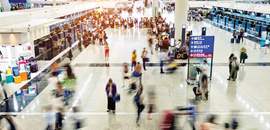- The U.S. stock market’s bounce since late March has reversed roughly half of the prior sell-off amid optimism coronavirus is ebbing and the lockdown of businesses is about to be eased. Optimists view the pandemic as a natural disaster that while devastating will inflict damage for only a short period.
- However, the pandemic differs from natural disasters in several respects: One is that without an effective antidote, coronavirus is still a threat. Consequently, the re-opening of businesses, which will be phased in across states, is dependent on more thorough testing and monitoring.
- A second difference is the pandemic is worldwide. According to the International Monetary Fund (IMF), the fallout could be the worst since the 1930s. Its latest forecast calls for global growth in 2020 to fall by 3% compared with flat growth in the 2009 global financial crisis (GFC).
- Since the onset of the pandemic, markets have fluctuated between fear and hope. While equity investors are looking beyond the near-term slump in activity, a reversal of the bounce could provide an opportunity for investors to rebalance their portfolios.
Background: Improved Market Sentiment
Following a record 35% plunge from mid-February to March 23, the U.S. stock market has recouped about one half of the decline. Amid this, there is an ongoing debate about whether a bottom has been established for the market or whether it is merely a bull rally in a bear market.
Unprecedented monetary and fiscal policy actions have played an important role in stabilizing financial markets. The Federal Reserve quickly reinstated the panoply of measures it undertook during the 2008-09 credit crunch, and it introduced a broader array of programs to bolster corporate bonds and municipal securities. At the same time, the $2.2 trillion fiscal package contained in the CARES Act is twice the size of the federal program enacted then. It is intended to bolster the social safety net by assisting small businesses and encouraging them to retain employees on their payrolls, while also providing increased transfer payments to individuals.
Investors have also been encouraged by a lessening of coronavirus in China and neighboring countries, as well as in hard hit countries in Europe such as Italy and Spain. In the U.S., there are signs that the virus has plateaued in New York City, and the federal government and state governments are now formulating plans to reopen some businesses. These developments have raised hopes that the worst of the pandemic may be over.
Meantime, the fallout from the widespread shutdowns and quarantines is coming to light. This past week, a series of economic indicators were released that showed the breadth and depth of declines in March: Retail sales posted an 8.7% decline, the largest monthly drop on record; industrial production fell 6.3%, the biggest monthly decline in 74 years; and housing was hit hard, with the homebuilders index plunging by 42 points to 30 in early April. They are a harbinger of more to come in the current quarter.
Looking ahead, the performance of markets will depend on whether investors look past near term damage to when normal business activity resumes. The unresolved issue is how long that will take.
Is the Pandemic Akin to a Natural Disaster?
For the most part, optimists view the coronavirus pandemic as a natural disaster such as hurricanes or earthquakes. The economy is immediately impacted by the destruction to homes and businesses, as well as loss of life left in the wake. Once the disaster passes, the rebuilding process can begin and a V-shaped pattern of recovery typically occurs.
Because the spread of coronavirus is finite and does result in destruction of the capital stock, some observers maintain the same economic pattern is likely this time. Unlike a natural disaster, however, no one can be certain when the worst is over, because the virus can be transmitted by people who are asymptomatic. Moreover, an antidote for COVID-19 could be a year or more away.
This past week, the White House authorized state governors to oversee a phased reopening of businesses. However, for people to return safely to their jobs or to congregate with others, medical experts and leaders in the business community contend the U.S. needs to accelerate testing and monitoring of the population. Thus far, only about one percent of the U.S. population has been tested.
The reopening will likely begin with smaller states where the incidence of coronavirus is the lowest. From an economic perspective, the eight largest states – California, Texas, New York, Florida, Illinois, Pennsylvania, Ohio, and New Jersey – account for one of half of U.S. GDP collectively. Because these states also have the highest incidence of coronavirus, their openings are likely to be delayed, which is a drag on GDP growth.
Meanwhile, the tally of people filing for unemployment insurance has risen to 22 million over the past four weeks, and it is expected to continue rising in the near term. As a result, some economists foresee the unemployment rate reaching 15%-20% eventually. In an article titled “The Human-Capital Costs of the Crisis,” Barry Eichengreen of the University of California, Berkeley, observes the toll the epidemic is taking:1
“Unlike a hurricane or earthquake, the coronavirus pandemic has caused no damage to the physical capital stock. But firm-specific skills have no value when the firm that uses them goes out of business, which is one reason why US productivity, wages, and economic growth are likely to be affected for years to come.”
To mitigate this risk, the CARES Act included the Paycheck Protection Program (PPP) that provides incentives for small businesses to keep their workers on the payroll. Under this program the Small Business Administration will forgive loans if all employees are kept on the payroll for eight weeks and the money is used for payroll, rent, mortgage payments and utilities. While it has proved to be highly popular, the program has run out of its initial funding of $350 billion and an expansion is currently being negotiated. Even then, it is expected to leave many small businesses unprotected.
The Pandemic Is a Worldwide Problem
A second key difference is that whereas natural disasters are local events, the coronavirus pandemic is a worldwide phenomenon. In a report issued this month, the IMF depicts “The Great Lockdown” as the “Worst Economic Downturn Since the Great Depression.”2
The latest IMF projections call for global GDP growth to decline by 3 percent, a downgrade of 6.3 percentage points from the forecast in January 2020 (Figure 1). By comparison, global growth was flat during the Global Financial Crisis in 2009, when China’s economy was able to generate double digit growth. The latest projections assume the pandemic peaks in the second quarter for most countries and recedes in the second half of this year.
The IMF anticipates global growth could rebound to 5.8% in 2021 assuming the pandemic does not reappear and policy actions worldwide are effective in preventing widespread bankruptcies, extended job losses and system-wide financial strains. Even then, the recovery would only be partial, as economic activity would remain below the level the IMF had previously forecast for 2021. The cumulative loss to global GDP over 2020-2021 from the pandemic is estimated to be around $9 trillion, which is greater than the economies of Japan and Germany combined.
| 2019 | Latest 2020 | Revision from January 2020 |
|
|---|---|---|---|
| World | 2.9 | -3.0 | -6.3 |
| Advanced Economies | 1.7 | -6.1 | -7.7 |
| U.S. | 2.3 | -5.9 | -7.9 |
| Euro Area | 1.2 | -7.5 | -8.8 |
| Japan | 0.7 | -6.5 | -7.9 |
| Emerging Economies | 3.7 | -1.0 | -5.4 |
| China | 6.1 | 1.2 | -4.8 |
| India | 4.2 | 1.9 | -3.9 |
Source: IMF, World Economic Outlook, April 2020.
Unlike the 2008-2009 global downturn, the impact on developing countries is expected to be particularly severe, because many are unprepared for coronavirus and their exports are being impacted by the slump in advanced economies and weak prices for oil and other commodities. The IMF also reports that net capital flows from emerging economies totaled $100 billion in the past two months. Calls for a comprehensive package of debt relief to assist poor countries have intensified after research showed that more than 60 countries are spending more on servicing their debt than on health care.
Investment Implications: Is the Glass Half Full or Half Empty?
Since late February, the stock market has been on a roller-coaster ride as investor sentiment has shifted from despair about coronavirus to hope that the worst is past. In the past few weeks, investors have largely shrugged off worsening economic news on grounds it is likely to be temporary and the U.S, economy will improve in the second half of this year.
The risk, however, is that even if the spread of coronavirus is plateauing, the economy may take considerably longer to recover for two reasons. One is the reopening of businesses is likely to be more gradual than optimists envision. The other is the damage that will have been inflicted will leave some businesses, especially small and mid-sized ones, obsolete. Accordingly, it will take time for many of the unemployed to find new jobs. Therefore, if return to normalcy is delayed some of the stock market’s bounce could be reversed, which could provide investors an opportunity to rebalance their portfolios.
1 Project Syndicate, April 10, 2020.
2 See Gita Gopinath, Chief Economist, IMF Blog, April 14, 2020.


















